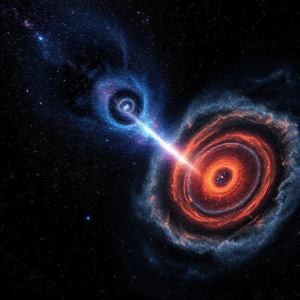1. Chaos Theory:
What is Chaos Theory?
Chaos theory is the study of systems that appear to be random or unpredictable, but are actually governed by underlying patterns and rules. These systems are extremely sensitive to initial conditions, meaning that even tiny changes at the start can lead to vastly different outcomes. This is also known as the “butterfly effect.”

Key Ideas:
- Sensitive Dependence on Initial Conditions: Small differences in the starting point of a system can lead to very different outcomes. Imagine trying to predict the weather: tiny changes in air pressure today can lead to completely different weather a week later.
- Nonlinearity: In chaotic systems, outputs aren’t directly proportional to inputs. A small change can result in a big difference, or vice versa.
- Deterministic but Unpredictable: Chaos doesn’t mean “random.” These systems follow specific laws, but the complexity makes it impossible to predict their behavior over time. It’s like trying to predict the exact path of a bouncing ball in a crowded room.
Examples of Chaos:
- Weather systems: Weather patterns are chaotic because small changes (like temperature or wind speed) can lead to unpredictable changes over time.
- Population growth: In ecology, the size of an animal population can change unpredictably due to a variety of factors.
- Stock market fluctuations: While there are rules and patterns, the market can behave unpredictably in the short term due to many factors.
2. String Theory:
What is String Theory?
String theory is a theoretical framework in physics that suggests that the fundamental particles (like electrons and quarks) are not “points” but are instead tiny, vibrating strings. These strings vibrate at different frequencies, and their different vibrational modes create the particles we observe in the universe.
Key Ideas:
- Tiny Strings: Everything in the universe is made up of tiny vibrating strings, rather than point-like particles. The way these strings vibrate determines the properties of the particle they represent, such as mass and charge.
- Extra Dimensions: String theory suggests there may be extra dimensions beyond the three dimensions of space and one of time that we are familiar with. In fact, string theory requires as many as 10 or 11 dimensions to work mathematically, some of which might be curled up so small that we can’t see them.
- Unification of Forces: One of the big promises of string theory is that it could unify all the fundamental forces of nature (gravity, electromagnetism, the weak nuclear force, and the strong nuclear force) into one framework. In other words, it could be a “Theory of Everything” that explains how everything in the universe works at both the smallest and largest scales.
Why is it Important?
- Explaining Quantum Gravity: String theory provides a possible way to combine quantum mechanics (which describes the very small) and general relativity (which describes the very large, like gravity). These two theories currently don’t work well together, and string theory might provide a bridge.
- Extra Dimensions and the Multiverse: Some versions of string theory suggest the possibility of parallel universes and extra dimensions of space, radically changing our understanding of the cosmos.
Examples in Nature:
- Particles and Forces: All particles in the universe, like electrons and photons, could just be different vibrational modes of the same fundamental string.
3. M-Theory:
What is M-Theory?
M-theory is an extension of string theory that attempts to unify all the versions of string theory into a single framework. It suggests that the fundamental building blocks of the universe are not just one-dimensional strings, but could also be higher-dimensional objects, like branes (short for “membranes”). It introduces 11 dimensions of space-time, instead of the 10 in string theory.
Key Ideas:
- 11 Dimensions: M-theory proposes that there are 11 dimensions, rather than the 10 found in string theory. These extra dimensions are hidden from our view and might be very tiny.
- Branes (Membranes): While string theory focuses on one-dimensional strings, M-theory introduces the idea that our universe could be a 3-dimensional “brane” (like a sheet) floating in higher-dimensional space. The strings and particles we observe could be on or attached to these branes.
- Unification of Forces: Like string theory, M-theory aims to be a “Theory of Everything.” It suggests that all fundamental forces and particles are different manifestations of the same underlying object, whether they are strings or branes.
Why is it Important?
- Higher-Dimensional Physics: M-theory suggests that the universe is more complex than we experience in our everyday life. We live in a 3-dimensional world, but M-theory shows that our universe could be part of something much larger, involving more dimensions we cannot perceive.
- Understanding the Big Bang: M-theory could explain the origins of the universe, including the Big Bang, by describing how the universe came into existence from a higher-dimensional perspective.
What Makes It Special:
- M-theory is still evolving: Unlike traditional physics theories, M-theory is not yet fully formulated. It’s more of an umbrella theory that unites various string theories and presents new ways of thinking about the universe’s structure.
- Multiverse Theory: Some interpretations of M-theory imply that our universe might be one of many in a “multiverse,” where different universes could have different physical laws and properties.
In Summary:
- Chaos Theory deals with complex systems that are sensitive to initial conditions, making long-term prediction almost impossible despite being deterministic.
- String Theory suggests that everything in the universe, including matter and forces, is made from tiny, vibrating strings instead of point particles.
- M-Theory takes string theory a step further, proposing a higher-dimensional framework where our universe is one of many in a larger multiverse.
These theories explore the deepest questions about how the universe works, ranging from the unpredictability of complex systems (chaos) to the smallest building blocks of the cosmos (strings and higher dimensions).











